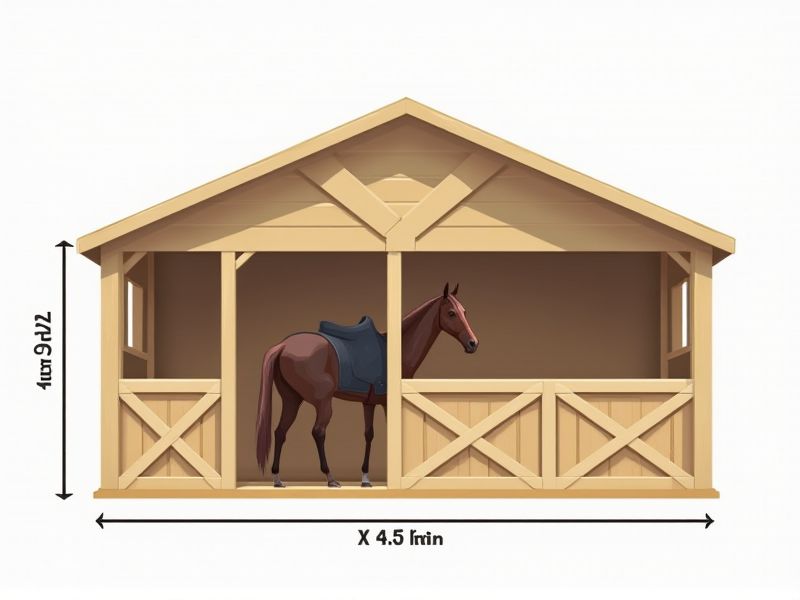
When planning a horse stable, it's essential to consider the comfort and safety of the horse. The standard dimension for a single horse stall is typically 12 feet by 12 feet (3.6 meters by 3.6 meters), providing ample room for the horse to move, lie down, and turn comfortably. If you have larger breeds, increasing the stall size to 12 feet by 14 feet is often recommended. Additionally, stalls usually have ceilings that are at least 8 feet high to ensure proper ventilation and to prevent injuries.
Adequate Size For Movement
A horse stable should provide a minimum of 12x12 feet per horse to ensure adequate space for comfortable movement and rest. This size facilitates natural behaviors, such as turning around and lounging, crucial for the horse's well-being. Stalls should include proper ventilation and flooring that minimizes injury risk, as these factors significantly impact horse health and mood. By prioritizing adequate size and safety features, you create an environment that promotes both physical and mental health for your horses.
Proper Ventilation
Proper ventilation in a horse stable ensures an optimal environment for equine health, significantly reducing the risk of respiratory issues. Fresh air circulation lowers ammonia levels from urine and manure, creating a more comfortable space for horses, particularly important for stabled animals that spend 12-24 hours a day inside. Ideal ventilation systems can lower moisture levels by up to 60%, which helps prevent mold and dust accumulation, critical for maintaining a healthy stable atmosphere. For your stable, consider incorporating adjustable vents, exhaust fans, and cross-ventilation techniques to promote natural airflow year-round.
Sufficient Ceiling Height
A sufficient ceiling height in a horse stable typically ranges from 10 to 12 feet to accommodate the movement and comfort of horses, especially larger breeds. This height prevents injuries caused by accidental collisions with fixtures or beams, ensuring a safer environment for equine residents. Proper ventilation, enhanced by this ceiling space, aids in maintaining a fresh atmosphere that promotes respiratory health for your horses. Compliance with these standards can significantly improve the overall well-being of your equine companions.
Safe Door Width
The standard door width for horse stables typically measures between 4 to 5 feet, ensuring a safe and comfortable entry for both horse and handler. This width accommodates various horse sizes, reducing the risk of injury during transitions. A safe door width also allows for easy maneuvering of equipment, such as feed carts and veterinary supplies, enhancing overall efficiency. Maintaining this standard in your stable design can promote the wellbeing of your horses and simplify daily management.
Appropriate Stall Depth
The appropriate stall depth for horse stables typically ranges from 10 to 12 feet, ensuring ample space for the horse to move comfortably. This depth allows for sufficient room to accommodate bedding materials, which play a crucial role in maintaining hygiene and comfort. A properly designed stall also minimizes the risk of injury, as horses can turn and lie down without constraints. By prioritizing these measurements, you can create an environment that promotes the overall well-being of your horses.
Durable Flooring Material
Durable flooring materials for horse stables include options like rubber mats and interlocking tiles, offering excellent shock absorption and slip resistance. Rubber flooring provides a non-porous surface, reducing the risk of bacterial growth and ensuring easy cleaning, making it ideal for maintaining hygiene in equine environments. With a lifespan of over 15 years, high-quality rubber mats can significantly lower long-term maintenance costs, while also promoting the safety and welfare of your horses. The investment in resilient flooring not only enhances the comfort of the stable but also contributes to the overall health and performance of your equine companions.
Optimal Wall Height
The optimal wall height for a horse stable ranges typically from 10 to 12 feet, ensuring ample ventilation and safety. This height prevents horses from easily jumping over while providing enough space for natural light to enter. Proper wall construction materials, such as treated wood or metal, enhance durability and reduce maintenance costs over time. Ensuring that your stable meets these height standards can significantly impact your horse's comfort and well-being.
Efficient Drainage System
An efficient drainage system in horse stables is essential for maintaining a healthy environment, ensuring proper waste management and minimizing the risk of disease. A well-designed drain can handle approximately 10-15 gallons per minute, swiftly removing excess water and waste materials. This system typically includes sloped flooring, perforated pipes, and sediment traps to effectively channel liquids away from horse areas. Implementing such a drainage solution can significantly enhance your stable's hygiene, prolonging the lifespan of flooring and reducing the need for costly repairs.
Strategic Window Placement
Strategic window placement in horse stables is essential for maintaining optimal ventilation and natural light, contributing to the overall well-being of horses. Windows should ideally be positioned to provide maximum sunlight exposure; for example, south-facing windows can harness direct sunlight for longer hours. Properly designed windows can also improve airflow, decreasing the risk of respiratory issues; stables with adjustable openings allow you to control air circulation based on weather conditions. It's important to ensure that the window height is appropriate to prevent horses from reaching out and potentially injuring themselves while still providing a safe and comfortable environment.
Accessible Feed And Water Setup
A high-quality horse stable should feature an accessible feed and water setup, ensuring your horses have easy access to essential nutrients and hydration. Incorporating automatic waterers can provide a continuous supply of fresh water, reducing the need for daily filling and promoting optimal hydration. Feed bins should be strategically placed at a height suitable for your horse's size, minimizing wastage and encouraging natural feeding behaviors. Regularly checking and replenishing feed supplies, ideally using non-permeable containers to keep it fresh, contributes significantly to your horse's health and well-being.
